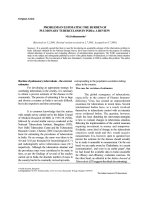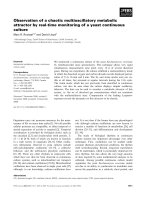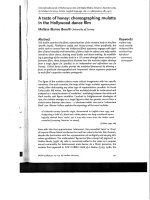foods of india a taste of culture
Bạn đang xem bản rút gọn của tài liệu. Xem và tải ngay bản đầy đủ của tài liệu tại đây (7.09 MB, 65 trang )
(c) 2011 Kidhaven Press. All Rights Reserved.
Barbara Sheen
(c) 2011 Kidhaven Press. All Ri
g
hts Reserved.
© 2007 by KidHaven Press. KidHaven Press is an imprint of The Gale Group, Inc.,
For more information, contact
KidHaven Press
27500 Drake Rd.
Farmington Hills, MI 48331-3535
Or you can visit our Internet site at
ALL RIGHTS RESERVED.
No part of this work covered by the copyright hereon may be reproduced or used in any form
or by any means—graphic, electronic, or mechanical, including photocopying, recording,
taping, Web distribution or information storage retrieval systems—without the written
permission of the publisher.
Every effort has been made to trace the owners of copyrighted material.
Printed in the United States of America
LIBRARY OF CONGRESS CATALOGING-IN-PUBLICATION DATA
Sheen, Barbara.
Foods of India / by Barbara Sheen.
p. cm. — (A taste of culture)
Includes bibliographical references and index.
ISBN-13: 978-0-7377-3553-6 (hardcover : alk. paper)
ISBN-10: 0-7377-3553-8 (hardcover : alk. paper)
1. Cookery, Indic—Juvenile literature. 2. India—Social life and customs—Juvenile
literature. I. Title.
TX724.5.I4S445 2007
641.5954—dc22
2006018758
(c) 2011 Kidhaven Press. All Ri
g
hts Reserved.
KidHaven™ and Cengage Learning™ are trademarks used herein under license.
a division of Cengage Learning, Inc.
Chapter 1
Colorful, Fragrant, and Delicious 4
Chapter 2
Common Threads 16
Chapter 3
Tasty Snacks 28
Chapter 4
Honored Guests 40
Metric Conversions 54
Notes 55
Glossary 57
For Further Exploration 59
Index 61
Pictures Credits 63
About the Author 64
Contents
(c) 2011 Kidhaven Press. All Rights Reserved.
Colorful,
Fragrant, and
Delicious
Chapter
1
I
ndian cooking is colorful, fragrant, and delicious. It
depends on a wide array of spices, legumes, and
grains for its distinct character.
An Ancient Treasure
India is the world’s chief supplier of spices and has
been for at least thirty-six hundred years. These fra-
grant and flavorful plant substances, which often have
been more prized than jewels, have drawn people from
all over the world to India throughout history.
Unlike spice seekers from other nations, Indians have
always had access to a wide array of different spices.
Some of the most popular spices include mint, bright or-
ange turmeric, pungent cumin, sweet and refreshing
4
(c) 2011 Kidhaven Press. All Rights Reserved.
Distribution of Foods and Spices
(c) 2011 Kidhaven Press. All Rights Reserved.
Many different ingredients
make up an Indian masala,
or spice mixture.
(c) 2011 Kidhaven Press. All Rights Reserved.
cardamom, parsley-like coriander, bitter-tasting kari
(cah-ree), cinnamon, and mustard seeds. Indian chefs
have been using these and other delicious spices to
preserve, color, flavor, and perfume their food for thou-
sands of years. Indian cuisine would not be the same
without them.
An Artful Combination
Indians use spices the way artists use paint, blending
them together in hundreds of different combinations
and proportions. For a dish to be considered well
cooked, no single spice should ever dominate. Instead
there must be a perfect balance of ingredients, with
each dish having its own distinctive taste, color, and
perfume. This means that cooks need to understand
the characteristics of each spice and how they mix to-
gether. Chef Mridula Baljekar explains: “Spices are the
heart and soul of Indian cooking. Knowing how to use
the spices is the key that unlocks the secrets of alluring
aromas and magical flavors of classic Indian cuisine.”
1
Indian cooks blend spices in a number of ways. They
create a masala (mah-saah-laah), a general term that
refers to any combination of ground spices. They make
masala by grinding different spices together into a pow-
der. This may be done in a stone dish known as a mor-
tar with a small, wooden, clublike tool called a pestle. A
food processor can also be used to save time. Garam
masala (gah-rahm mah-saah-laah), a favorite spice
mixture, is a specific blend of up to fifteen spices that is
widely used in Indian cooking. It features cinnamon,
Colorful, Fragrant, and Delicious
7
(c) 2011 Kidhaven Press. All Rights Reserved.
8
black pepper, cloves, cardamom, and other spices. It is
dark and zesty.
Spices are also used whole. Roots, pods, seeds, and
leaves are fried for less than a minute in hot oil or ghee
(gee). Ghee is a type of butter in which all the milk
solids have been removed. Incredibly fragrant, the
spiced or tempered oil is used as a basis for hundreds
of different sauces.
Rice and Grains
Sauces are often served over rice, a staple of the Indian
diet and an important part of Indian culture. Rice sym-
bolizes good fortune in India, which is why rice por-
ridge is the first solid food fed to babies. It is also the
most important crop in India, with one-fourth of all
cultivated land planted with it.
Although many varieties of rice are grown, basmati
(bas-maah-tee) rice is the most popular. It is known for
its smooth, rich taste and fresh aroma. Basmati literally
means “the queen of perfumes” in Hindi, one of the
most common languages spoken in India. Indians have
many uses for basmati rice. It is boiled and topped with
a spicy sauce filled with meat or vegetables. It can also
be stir-fried with spices, used in puddings, puffed into
a popcorn-like snack, or cooked in aromatic casseroles.
Indians eat about 4
1
⁄2 pounds (2 kg) of rice a week. Be-
fore cooking it, they carefully rinse the rice. This re-
moves impurities and excess starch and keeps the
grains from sticking together. Then the rice is soaked for
at least an hour before it is boiled. Soaking whitens the
Foods of India
(c) 2011 Kidhaven Press. All Rights Reserved.
Colorful, Fragrant, and Delicious
9
Rice with Cumin
This is a wonderfully scented rice dish. It uses bas-
mati rice, but any long-grain rice can be substi-
tuted. Cumin seeds are sold in the spice section of
supermarkets.
Ingredients
1 tablespoon vegetable oil for frying
1 teaspoon cumin seeds
1
⁄2 teaspoon black pepper
2 cups basmati or other long grain rice
4 cups water
1
⁄2 teaspoon salt
Instructions
1. Heat the oil in a large saucepan over medium heat. Add
the cumin and pepper. Stir-fry for about 45 seconds. Add
the rice and stir-fry for one minute.
2. Add the water and salt. Bring the rice to a boil. Reduce
heat to low, cover the pan, and simmer until the water is
absorbed and the rice is tender, about ten minutes.
3. Remove the rice from heat. Leave the rice covered for
about five minutes. Uncover carefully, because hot steam
will escape. Fluff with a fork and serve.
Serves 4.
A rice vendor sells packets
of Basmati rice.
(c) 2011 Kidhaven Press. All Rights Reserved.
10
rice and helps the grains absorb the flavor of the spicy
sauces that will be poured over them. According to au-
thors Martin Hughes, Sheema Mookherjee, and Richard
Delacy, the end result is, “white, long, and silky.”
2
Wonderful Breads
Although rice is eaten at every meal in southern India
and in great quantities in northern India, flat breads
known as rotis (ro-tees) are the core of northern meals.
Rotis are also popular in the rest of the nation. Roti
Foods of India
Indian flat breads called rotis cook on a hot griddle outdoors.
(c) 2011 Kidhaven Press. All Rights Reserved.
originated centuries ago as a portable food that farm-
ers and shepherds could dine on when they were out in
the fields. Today Indians use rotis like edible spoons to
scoop up saucy dishes, meat, and vegetables.
Rotis are made without yeast from nutrient-rich
whole-wheat flour, which is mixed with water and
kneaded to form a thin dough. The dough is divided
into tennis ball–size portions, rolled into almost per-
fect circles, and cooked on a hot cast-iron griddle
known as a tawa (tah-waah).
Cooks make a wide variety of rotis, but the most
common is chapati (chah-paah-tee), a soft flat bread
that balloons out as it cooks. Other favorites include
pooris (poo-rees), which are deep-fried chapatis, and
paranthas (pah-rahn-thahs), which have a pastry-like
texture. Many Indian cooks make fresh roti for every
meal. Traditionally the woman of the house makes the
bread as the family eats. When the roti is done, she
brushes it with butter to keep it soft and transfers it
from the griddle to the table. “This is simple . . . home
cooking,” explains a chef at the Indian Foods Company.
“I cannot go for many days without my roti.”
3
Colorful Legumes
Legumes are another essential part of the Indian diet.
Legumes such as lentils, beans, and peas are eaten at
least once a day. They are usually flavored and scented
with spices and served over rice, or with roti and a veg-
etable. Since they are loaded with vitamins, minerals,
protein and fiber they are quite nutritious. This may be
Colorful, Fragrant, and Delicious
11
(c) 2011 Kidhaven Press. All Rights Reserved.
12
Foods of India
Lentil Dal
This simple dal recipe uses lentils. Yellow split peas
can be substituted.
Ingredients
1 cup dried lentils
2 cups water
1
⁄2 teaspoon salt
1
⁄2 teaspoon turmeric
1
⁄2 teaspoon cayenne pepper
1 onion, finely chopped
1 tablespoon minced garlic
1 tablespoon vegetable oil or butter for frying
Instructions
1. Combine lentils, water, salt, and turmeric in a saucepan and
bring to a boil. Lower the heat, cover the pan, and simmer
until the lentils are cooked and much of the water is
absorbed, about twenty minutes. The mixture should be
soft and thick when done. If the mixture starts to stick to
the pot during cooking, add more water.
2. Heat oil in a frying
pan. Add onions,
garlic, and cayenne
pepper. Fry over
low heat until the
onions are
translucent.
3. Stir the onion
mixture into the
lentils. Serve with
rice.
Serves 4.
(c) 2011 Kidhaven Press. All Rights Reserved.
why an Indian proverb says that legumes and roti are
all an Indian needs to survive. Indian cooks use over 60
different types of legumes. These include tiny yellow
split peas; black, yellow, and pink lentils; and tan chick-
peas. One of the favorite ways of using legumes is in dal
(dahl), a delicious stewlike dish. Each cook has his or
her own dal recipes, so there are countless variations.
Depending on the cook, dal can contain just one type
of legume or a few. It can be thick and chunky, or the
lentils may be mashed so that the dal is thin and velvety
smooth. But what gives dal its special taste and aroma
are the spices that flavor it.
To make dal, cooks soak the legumes overnight to
soften them. Then they simmer them for hours. When
Colorful, Fragrant, and Delicious
13
Vegetables
Indians eat a lot of vegetables. Vegeta-
bles are served at almost every meal and
are cooked in a wide variety of ways.
They are often the main ingredients in
spicy sauce dishes. They are roasted in a
tandoor, made into fritters, threaded on kabobs, stir-fried,
or mashed.
Some Indian vegetables are familiar to Westerners, while
others are not. Potatoes, onions, spinach, eggplant, cabbage,
cauliflower, and thin, sweet carrots are very popular. White
pumpkins, which are cooked in a spicy sauce, are less famil-
iar. Other unusual vegetables include purple and white yams,
various edible gourds, the roots of the lotus flower, and
white radishes. Plantains, large, green, banana-like fruits, are
fried and sprinkled with spices.
(c) 2011 Kidhaven Press. All Rights Reserved.
A vendor displays her wares at
an outdoor fruit and vegetable
market in Pushkar, India.
(c) 2011 Kidhaven Press. All Rights Reserved.
the legumes are tender, selected spices are
cooked in hot oil or ghee and added to
the legumes right before they are
served. This gives the legumes, which
are otherwise bland, a savory flavor
and a mouthwatering aroma. Popular
combinations include pink lentils
spiced with cumin, pepper, and chili
powder, or yellow split peas flavored
with mashed garlic, ginger, and cinna-
mon.
Mint is often added to the stew. And
sometimes yogurt is mixed into dal to
give it a creamy texture. One thing is cer-
tain: No matter the ingredients, Indians love
dal. “There is something wonderfully warm and tasty
about . . . dal,” explains chef Suvir Saran. “I want [it]
when I have a craving for something simple and
homey, but still savory.”
4
Indian cooking is, indeed, warm and tasty. Indian
chefs artfully combine brightly colored legumes, richly
perfumed spices, and deliciously satisfying grains to
create dishes that are uniquely Indian.
Colorful, Fragrant, and Delicious
15
Pea Pod
(c) 2011 Kidhaven Press. All Rights Reserved.
Common
Threads
Chapter
2
I
ndia is a large country with many geographic differ-
ences. Plains, deserts, thousands of miles of coastline
dotted with tropical beaches, and snow-capped moun-
tains all are a part of India. This geographic diversity af-
fects what the 1 billion people who live here eat. For
example, coconuts, seafood, and tropical fruit are pop-
ular on the coasts where they are cultivated. Thick
stews that warm the body are favorites in the cold
mountains.
Religious rules also influence the Indian diet. Indians
are divided into a number of religious groups. Eighty per-
cent are Hindus and 13 percent are Muslims. There are
also Sikhs and Buddhists, among others. Few Muslims
16
(c) 2011 Kidhaven Press. All Rights Reserved.
eat pork, while most Hindus avoid beef. Many Hindus,
Sikhs, and Buddhists are vegetarians. As a matter of fact,
there are more vegetarians in India than in any other na-
tion. Despite these differences, the use of spices and sim-
ilar cooking methods bind all Indian cooking together.
Spicy Sauces
Curry is probably the most famous of all Indian foods.
It is not a single dish and there is no basic recipe for it.
Curry actually describes any dish cooked in a spicy
Mealtime is a special time for this boy and his family.
(c) 2011 Kidhaven Press. All Rights Reserved.
18
sauce. This usage dates from the mid-1800s when the
British ruled India. The British used the word curry,
taken from the spicy Indian herb kari, for all spicy
dishes. A wide range of popular, stewlike dishes are
bathed in zesty sauces. Each has different main ingre-
dients, but the basis for every one is a savory sauce
made from a blend of aromatic spices.
Indian cooks create these sauces in layers. First a com-
bination of spices, which usually includes garam masala,
is cooked in hot oil or ghee with nuts or grated onions.
Foods of India
Spicy chicken curry is just one of many curries enjoyed by Indians.
(c) 2011 Kidhaven Press. All Rights Reserved.
Then yogurt, which adds a pleasant tartness, or tomatoes
follow. The main ingredients, which include a variety of
vegetables and/or meat or seafood, come next. Water is
added, and the stew is cooked until all the flavors blend
deliciously and the ingredients are buttery soft.
Common Threads
19
Eating in India
Some mealtime customs in India are dif-
ferent from customs in North America. For
instance, in India food is rarely served in
serving bowls. Instead, each diner is given
a round metal tray called a thali (taah-
lee). On it are small bowls containing different dishes such
as rice, dal, chicken korma, potatoes, chutney, and raita.
Instead of utensils, food is eaten with the right hand. The
left hand, which is used for personal hygiene, is never used
for eating. Diners use the tips of their fingers to pick up food
and their thumbs to scoop the food into their mouths.
A thali, or food tray, holds a variety of foods and seasonings.
(c) 2011 Kidhaven Press. All Rights Reserved.
20
Foods of India
Many Dishes
Indians make hundreds of different kinds of saucy, stew-
like dishes, which are eaten with rice or roti. Depending
on the spices, the stews can be fiery or mild. Kormas
(kor-maahs), for instance, are rich and mild. Main ingre-
dients such as vegetables, chicken, lamb, or seafood are
smothered in a creamy sauce flavored with cinnamon,
nutmeg, pepper, and mustard seeds. The mixture is then
thickened with coconut milk and almond paste. The re-
sult is fragrant, velvety, and delicious.
A favorite Indian dinner includes the hot and spicy stew called roghan
josh, dal, rice, and flat breads.
(c) 2011 Kidhaven Press. All Rights Reserved.
Zestier stews are also quite popular. Roghan josh
(ro-gahn josh) is hot and spicy. Its sauce is made with
garam masala cooked with lamb and topped with fried
tomatoes and onions. Vindaloo (vin-dah-loo) dishes
are even hotter. Pork vindaloo is popular, but vindaloos
also feature vegetables or lamb. The main ingredient is
marinated in a sweet-and-sour sauce made of vinegar,
ginger, and garlic. This mixture is then topped with a
second sauce flavored with cumin, turmeric, and
whole, dried chilis. Even though vindaloo dishes are
fiery, the taste is not unpleasant. Like all Indian stews,
vindaloo has a delicate flavor that lingers on the palate.
“I call this back heat,” explains Suvir Saran. “It goes and
goes in your mouth long after you’ve swallowed the
bite!”
5
Crisp, Moist, and Succulent
Other deliciously spiced foods are cooked in a tandoor
(tahn-dur). A tandoor is a barrel-shaped clay oven. It
was brought to India in the 10th century by Persians
fleeing their Arab conquerers.
Much like Americans have barbeque grills, some In-
dians have a tandoor in their backyards. For those who
do not have one, there are tandoor restaurants, which
are the most popular restaurants in India.
To use a tandoor, cooks build a charcoal fire in its
bottom. The heat can reach as high as 850°F (450°C).
Such intense heat cooks food rapidly and locks in mois-
ture. Food cooked in a tandoor is crisp on the outside
and soft and juicy within.
Common Threads
21
(c) 2011 Kidhaven Press. All Rights Reserved.
Flat breads are baked over
high heat in a tandoor.
(c) 2011 Kidhaven Press. All Rights Reserved.
Most any food can be cooked in a tandoor. And
many different foods can be grilled, baked, or
roasted at the same time. “It must be the most ver-
satile oven in the world,” says Baljekar. “The cook
can, as if by waving a magic wand, produce a variety
of dishes.”
6
Common Threads
23
Chicken Tikka
Chicken tikka can be made on a grill or in an oven.
The longer the chicken marinates, the tastier it
gets.
Ingredients
1
⁄2 cup plain yogurt
juice of 1 lemon
1 teaspoon cayenne pepper
1 teaspoon chili powder
1 teaspoon grated ginger
1 teaspoon turmeric
1 teaspoon salt
1 tablespoon tomato sauce
4 chicken breasts, cut into cubes
Instructions
1. Mix all the ingredients except the chicken together in a
large bowl. Add the chicken. Put in the refrigerator to
marinate one hour to overnight.
2. Preheat the oven to 375°F. Put the chicken on skewers.
Place the skewers across a drip tray sprayed with nonstick
spray or lined with aluminum foil.
3. Cook the meat until it is no longer pink inside, about
twenty minutes. Serve with mint chutney.
Serves 4.
(c) 2011 Kidhaven Press. All Rights Reserved.
24
Foods of India
Mint Chutney
Mint chutney is served with almost every meal.
Chopped green mango can be used to add tart-
ness. Use more chilis for a spicier taste and fewer
for a milder taste.
Ingredients
1 cup fresh mint leaves
1 cup fresh cilantro, chopped
3 green onions, chopped
2 green chilis, chopped, seeds and stem removed
1 teaspoon minced ginger
1 teaspoon minced garlic
1 teaspoon sugar
1
⁄2 teaspoon salt
2 tablespoons water
juice of one lemon
Instructions
1. Combine all ingredients in a food processor or blender.
Puree until the mixture becomes a paste.
2. Makes one cup. Refrigerate until ready to serve. Serve with
any Indian dish or with crackers.
Until the 19th century, tandoors were used just to
bake naan (nahn), an Indian flat bread. Naan is made
by pressing dough onto the hot oven’s walls. Many In-
dian villages had a communal tandoor in the middle of
the town that villagers used to make their bread.
Today whole chickens, known as tandoori chicken,
and chunks of lamb or chicken, known as tikka (tee-
kah) kebabs, are commonly made in the clay oven. To
(c) 2011 Kidhaven Press. All Rights Reserved.









